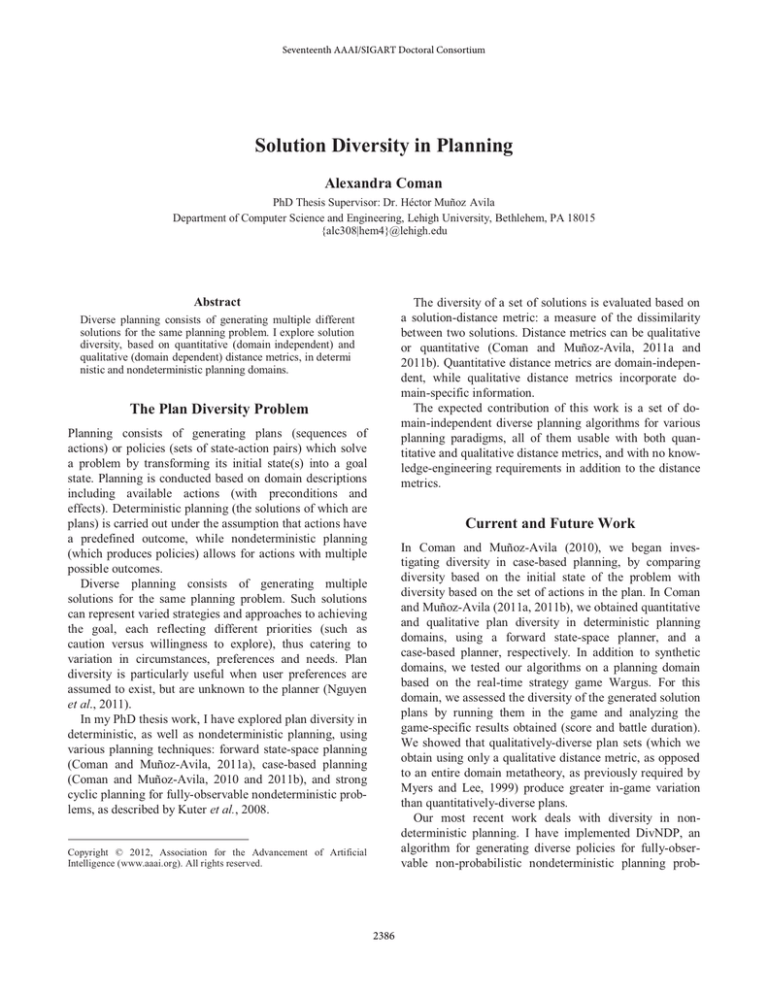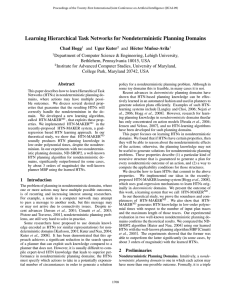
Seventeenth AAAI/SIGART Doctoral Consortium
Solution Diversity in Planning
Alexandra Coman
PhD Thesis Supervisor: Dr. Héctor Muñoz Avila
Department of Computer Science and Engineering, Lehigh University, Bethlehem, PA 18015
{alc308|hem4}@lehigh.edu
The diversity of a set of solutions is evaluated based on
a solution-distance metric: a measure of the dissimilarity
between two solutions. Distance metrics can be qualitative
or quantitative (Coman and Muñoz-Avila, 2011a and
2011b). Quantitative distance metrics are domain-independent, while qualitative distance metrics incorporate domain-specific information.
The expected contribution of this work is a set of domain-independent diverse planning algorithms for various
planning paradigms, all of them usable with both quantitative and qualitative distance metrics, and with no knowledge-engineering requirements in addition to the distance
metrics.
Abstract
Diverse planning consists of generating multiple different
solutions for the same planning problem. I explore solution
diversity, based on quantitative (domain independent) and
qualitative (domain dependent) distance metrics, in determi
nistic and nondeterministic planning domains.
The Plan Diversity Problem
Planning consists of generating plans (sequences of
actions) or policies (sets of state-action pairs) which solve
a problem by transforming its initial state(s) into a goal
state. Planning is conducted based on domain descriptions
including available actions (with preconditions and
effects). Deterministic planning (the solutions of which are
plans) is carried out under the assumption that actions have
a predefined outcome, while nondeterministic planning
(which produces policies) allows for actions with multiple
possible outcomes.
Diverse planning consists of generating multiple
solutions for the same planning problem. Such solutions
can represent varied strategies and approaches to achieving
the goal, each reflecting different priorities (such as
caution versus willingness to explore), thus catering to
variation in circumstances, preferences and needs. Plan
diversity is particularly useful when user preferences are
assumed to exist, but are unknown to the planner (Nguyen
et al., 2011).
In my PhD thesis work, I have explored plan diversity in
deterministic, as well as nondeterministic planning, using
various planning techniques: forward state-space planning
(Coman and Muñoz-Avila, 2011a), case-based planning
(Coman and Muñoz-Avila, 2010 and 2011b), and strong
cyclic planning for fully-observable nondeterministic problems, as described by Kuter et al., 2008.
Current and Future Work
In Coman and Muñoz-Avila (2010), we began investigating diversity in case-based planning, by comparing
diversity based on the initial state of the problem with
diversity based on the set of actions in the plan. In Coman
and Muñoz-Avila (2011a, 2011b), we obtained quantitative
and qualitative plan diversity in deterministic planning
domains, using a forward state-space planner, and a
case-based planner, respectively. In addition to synthetic
domains, we tested our algorithms on a planning domain
based on the real-time strategy game Wargus. For this
domain, we assessed the diversity of the generated solution
plans by running them in the game and analyzing the
game-specific results obtained (score and battle duration).
We showed that qualitatively-diverse plan sets (which we
obtain using only a qualitative distance metric, as opposed
to an entire domain metatheory, as previously required by
Myers and Lee, 1999) produce greater in-game variation
than quantitatively-diverse plans.
Our most recent work deals with diversity in nondeterministic planning. I have implemented DivNDP, an
algorithm for generating diverse policies for fully-observable non-probabilistic nondeterministic planning prob-
Copyright © 2012, Association for the Advancement of Artificial
Intelligence (www.aaai.org). All rights reserved.
2386
therefore not assuming action-outcome probabilities and
state-transition cost or reward information to be available.
To our knowledge, our work is the first on diversity in
non-probabilistic nondeterministic planning.
The related problem of plan similarity has been addressed by Fox et al. (2006).
Outside planning, solution diversity has been explored in
case-based reasoning for analysis tasks (Smyth and
McClave, 2001, and many others).
lems. DivNDP is built upon NDP (Kuter et al., 2008), a
state-of-the-art nondeterministic planner, and generates k
diverse policies as follows: first, it generates a policy using
regular NDP; then, it generates (k-1) additional policies
using a modified version of NDP which favors candidate
partial policies that are evaluated as being more distant
from previously-generated policies. Experimental results
on synthetic nondeterministic planning domains show that
DivNDP produces highly diverse solution sets without
unreasonably inflating solution size (an indicator of
solution quality, according to Kuter et al., 2008).
Currently, I am conducting a comparison of our heuristic-search-based and case-based diverse deterministic planning methods, with regard to the diversity of generated
plans, as well as to planning speed. I expect this work to be
completed by the time of the Doctoral Consortium.
In the final year of my PhD studies, I plan to work on
generating qualitatively-diverse policies with DivNDP:
while the algorithm can be used with any distance metric,
we have so far only tested it with a quantitative one. I
would also like to extend the range of test domains so as to
include compelling non-synthetic nondeterministic domains (such as computer games), which allow the diversity
of generated policies to be assessed by running them in
their intended environment and evaluating the results (as
we have already done in deterministic planning). I expect
that such complex domains will introduce additional
efficiency concerns, making it necessary to devise methods
for enhancing planning performance.
Acknowledgements
This work was supported in part by NSF grant 0642882
and NRL.
References
Bryce, D.; Cushing, W.; and Kambhampati, S. 2007. Model Lite
Planning: Diverse Multi option Plans & Dynamic Objective
Functions. ICAPS 2007 Workshop on Planning and Plan
Execution for Real World Systems.
Coman, A., and Muñoz Avila, H. 2010. Case based Plan
Diversity. In Proceedings of ICCBR 2010, 66 80. Springer.
Coman, A., and Muñoz Avila, H. 2011a. Generating Diverse
Plans Using Quantitative and Qualitative Plan Distance Metrics.
In Proceedings of AAAI 2011, 946 951. AAAI Press.
Coman, A., and Muñoz Avila, H. 2011b. Qualitative vs.
Quantitative Plan Diversity in Case Based Planning. In
Proceedings of ICCBR 2011, 32 46. Springer.
Eiter, T.; Erdem, E.; Erdogan, H.; and Fink, M. 2012. Finding
Similar/Diverse Solutions in Answer Set Programming.
arXiv:1108.3260v1. To appear in Theory and Practice of Logic
Programming.
Fox, M.; Gerevini, A.; Long, D.; and Serina, I. 2006. Plan
Stability: Replanning versus Plan Repair. In Proceedings of
ICAPS 2006, 212 221. AAAI Press.
Kuter, U.; Nau, D. S.; Reisner, E.; and Goldman, R. P. 2008.
Using Classical Planners to Solve Nondeterministic Planning
Problems. In Proceedings of ICAPS 2008, 190 197. AAAI Press.
Myers, K. L., and Lee, T. J. 1999. Generating Qualitatively
Different Plans through Metatheoretic Biases. In Proceedings of
AAAI 1999, 570 576. AAAI Press/The MIT Press.
Nguyen, T.; Do, M.; Gerevini, A.; Serina, I.; Srivastava, B.;
Kambhampati, S. 2011. Generating Diverse Plans to Handle
Unknown and Partially Known User Preferences. Technical
report arxiv: 1101.2279. To appear in Artificial Intelligence.
Smyth B., and McClave, P. 2001. Similarity vs. Diversity. In
Proceedings of ICCBR 2001, 347 361. Springer.
Srivastava, B.; Kambhampati, S; Nguyen, T.; Do, M.; Gerevini,
A.; and Serina, I. 2007. Domain Independent Approaches for
Finding Diverse Plans. In Proceedings of IJCAI 2007, 2016 2022.
AAAI Press/IJCAI.
Related Work
In deterministic planning, Srivastava et al. (2007), Nguyen
et al. (2011), and Eiter et al. (2012) obtain quantitative
plan diversity; Myers and Lee (1999) obtain qualitative
plan diversity through the use of a domain metatheory
providing high-level, domain-specific information. In all of
the above-mentioned work, the test domains are synthetic,
and diversity assessment is conducted solely by analyzing
the sets of plans themselves. We obtain both quantitative
and qualitative plan diversity without requiring a domain
metatheory. Our test domains include a non-synthetic one
(Wargus), the plans for which we evaluate by running them
in the game environment, and assessing the diversity of the
obtained results.
In probabilistic planning, Bryce, Cushing, and
Kambhampati (2007) generate multi-option plans using a
modified version of the LAO* algorithm. We address
diversity in non-probabilistic nondeterministic planning,
2387








